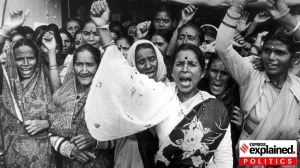This Rajasthan district with a death wish needs a helpline
SRI GANGANAGAR, SEPTEMBER 19: This district seems to be living on the edge and is fast becoming Rajasthan's death row. In the dusty, prosp...

SRI GANGANAGAR, SEPTEMBER 19: This district seems to be living on the edge and is fast becoming Rajasthan’s death row. In the dusty, prosperous and largely agrarian Sri Ganganagar district, bordering Punjab and Pakistan, suicides and threats to end one’s life are spiralling. Last year in Sri Ganganagar town and adjoining Hanumangarh, 235 people embraced death while by August this year, the figure had touched 220.
Any reason seems to be good enough to end one’s life by consuming pesticides, immolation, hanging and drowning. Middle and lower middle class men and women in the age-group of 18-40 are the most vulnerable and are driven over the edge by trivial matters. Topping the list are relationship problems — family and marital disputes.
The trend became apparent in 1994 when 127 suicides were reported in the district. Next year the figure rose to 153 and had touched 181 in 1997. In 1998, there was a decline with 165 cases reported. But that was the year when a bizarre suicide took place and added to the headache of the local police.
Since 1999, the police here has received 48 neatly typed suicide threats, signed — some collectively — by 82 people. These included 12 government employees and a teacher. Their provocation — grievances like non-receipt of pension dues, farmers receiving less water in the canals, a teacher not getting a job at the local school, family and property disputes etc.Each such threat carries a deadline and gives the date and time of the intended suicide. The district administration can ignore all this at its own peril.
That’s the lesson it learnt in July 1998 when a 42-year-old BJP councillor, Lakshman Khichi, immolated himself. He had threatened the extreme act if his demand for a road and some drains was not met. When his pleas went unheard, he was driven to his death. Disguised as a home-guard, he immolated himself outside the Collectorate after dousing himself with petrol. This sparked a state-wide agitation and Khichi became a hero overnight. His bust was installed at one of the busiest chowks in the town and the intersection named after him.
Caught off-guard, the police revised its strategy. Each person issuing a threat is now located and bound down by a magisterial order. Says SP Ravi P Meherda: “We even send people to judicial custody to prevent them from committing suicide.”
Some of the threats are quite ludicrous. The wife of a former managing director of the town’s urban bank, recently implicated in a scam, threatened to commit suicide if she was harassed during the inquiry. A youth, Vidarbha, threatened to commit suicide if a JCT cloth mill was not opened in the region.
And what about those who took the final step? In the summer of 1999, the town witnessed six immolations within a week — four in Sri Ganganagar and two in Hanumangarh — all at a public maidan. There was no pressing reason for any of them to die. Stresses psychiatrist Dr Roop Sidana: “Here there is no stigma associated with suicide. People have too many models to follow and take this way out at the slightest provocation.”
Take the case of a 19-year-old educated village youth who fought with his father over his wish to study in Australia, something which his father could not afford. So, he promptly popped some poisonous tablets.
The absence of social bonding and roots is one of the main catalyst for this trend. The region is a melting pot of different cultures. People have migrated here from Punjab, Bihar, UP and even Pakistan’s Bhawalpur. Cheap land and good irrigation facilities were the incentives 60 years ago. So rather than the Rajasthani culture of thrift striking roots here, it’s the Punjabi consumerist culture that dominates.
It’s a society in transition. As psychiatrist Sidana puts it: “From farming, they are slowly entering city life as land is converted into cash.” Sri Ganganagar town is clogged with shops selling expensive consumer goods like television sets and washing machines. Those who can’t afford feel deprived and small.
There is also the widespread addiction to liquor and opium husk to contend with. Six years ago the rural-urban transition accelerated and alcoholism increased. In fact, during the days of prohibition in Haryana, tipplers had turned to Sri Ganganagar.
In the past two years, there has been a five-fold rise in unemployment in the region. The prosperous cotton belt has also been badly hit by pests and waterlogging. SP Meherda says: “It has become a stagnant town now, not a growing one, and industry is non-existent in the region.”
Psychiatrist Dr Rajiv Aggarwal cites breakdown of the joint family system as a major reason. “The wife who remains with her in-laws feels she is deprived and that her brother-in-laws who have moved away are leading happier lives.” Adds Dr Sidana: “There has been an erosion of cultural and religious values. The Sikh boys here who go from their farms to study in English medium schools want to cut off their hair and be like their friends, but the parents are rigid. So there’s conflict.”
Recently, a farmer’s daughter who had studied at Delhi’s Lady Shri Ram College was married off to a farmer in a village in this district. Unable to adjust to her new life, she committed suicide after a few days.
Psychiatrists in Sri Ganganagar attend to 30 to 80 patients daily, most affected by depression. They are mostly from rural areas and come with their entire family in tow, and there is no social stigma attached to visiting a psychiatrist.
There are few counsellors in the region who can pull people away from the brink. Efforts are being made to motivate social organisations to launch a lifeline to help people with suicidal tendencies. As of now, the suicide figure — 10.3 per lakh — is higher than the national average of 10.14 recorded by the National Crime Records Bureau.



- 01
- 02
- 03
- 04
- 05




























